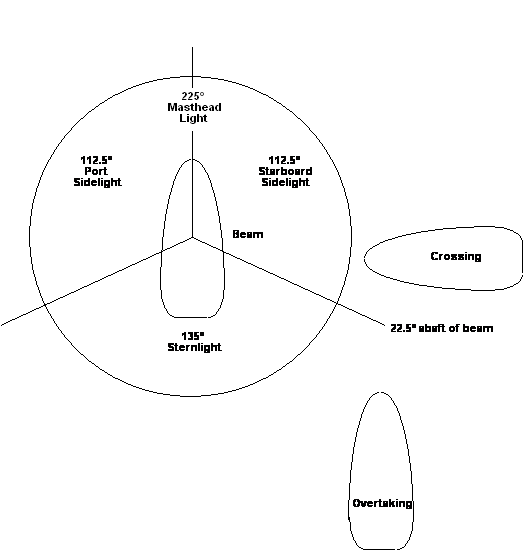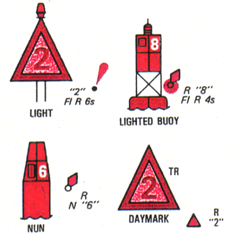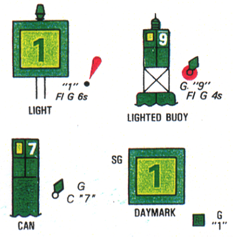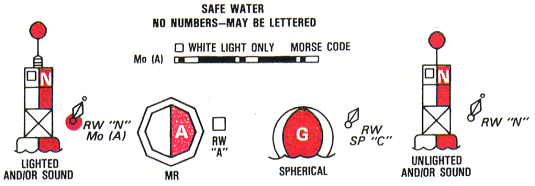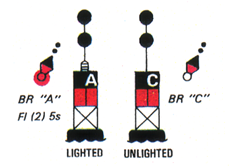Download Boating Tip #21: Identifying Lights (PDF format, 55KB)
Many types of vessels can be identified at night by their unique light colors or patterns, which they display in addition to their sidelights and sternlight.
Vessels not under command (NUCs) display two all–round red lights. (Memory aid: Red over red, the captain is dead).
 |
| NUC under way and making way |
Vessels restricted in their ability to maneuver (RAMs), display three all–round lights. The top and bottom lights are red and the middle light is white. If the vessel is restricted in her ability to maneuver because she is tending SCUBA or recreational divers, a rigid replica of the international code flag A (alpha) must also be displayed. If the vessel is engaged in underwater operations or dredging, in addition to the red–white–red all–round lights, two all–round red lights are displayed on the side of the vessel on which the obstruction exists, and two all–round green lights are displayed on the side of the vessel on which it is safe to pass. (Memory aid: Red, white, red, working ahead).
 |
 |
| RAM with obstructions, not making way | Ram underway and making way |
Although highly unlikely, if you come across a vessel displaying three green all–round lights in a triangular pattern, stay away. You should not approach within 1,000 meters because the vessel is engaged in minesweeping operations. (Memory aid: Green, green, green, mines may be seen).
 |
| Minesweeper underway and making way, and heading right at you |
On international waters, a power driven vessel constrained by draft displays three all–round red lights in a vertical line. (Memory aid: Rudder rubbing rocks).
 |
| CBD, under way and making way |
A red all–round light displayed above a white all–round light indicates that the vessel is a commercial fishing boat engaged in fishing, while a green all–round light displayed above a white all–round light indicates the vessel is engaged in trawling and is dragging nets through the water. (Memory aid: Red over white, I’m eating fish tonight. Green over white, I’m eating shrimp tonight).
 |
 |
| Fishing vessel anchored or underway but not making way |
Fishing vessel underway |
Anchored vessels less than 50 meters in length display one all round white light. Vessels 50 to 100 meters in length display two all–round white lights, one high up at the bow, and one lower near the stern. Large vessels greater than 100 meters in length, also display two all–round white lights, but in addition are required to illuminates the decks.
 |
| Anchored vessel > 50 meters but < 100 meters in length |
If the vessel is aground rather than anchored, the same white anchor lights are displayed, but in addition two all–round red lights are displayed, indicating the vessel is not under command.
 |
 |
| Vessel aground < 50 meters in length | Vessel aground > 50 meters in length |
A pilot vessel while engaged in piloting duties, displays a white all–round light over a red all–round light. (Memory aid: White over red, the pilot’s ahead).
 |
| Pilot vessel while on pilotage duty |
Hovercraft or air–cushioned vessels while in the non displacement mode, display a yellow all–round light which flashes at a rate of 120 flashes per minute. (Memory aid: Flash yellow when hovering).
 |
| Hovercraft in non displacement mode |
Law enforcement vessels may display a flashing blue light. (Memory aid: Flash blue when chasing).
 |
| Law enforcement vessel |
Sailboats display running lights only (sidelights and a sternlight) rather than steaming lights. If the sailboat is less than 20 meters long, a red, green and white tri–light may be carried on top of the mast instead of the sidelights and a sternlight. Or instead, a sailboat can display sidelights, a stern light, and a red all–round light over a green all–round light on top of the mast. If a sailboat is operating under auxiliary power, steaming lights should be displayed, and if applicable, the red and green all–round lights should be turned off. (Memory aid: Red over green, I’m a sailing machine).
 |
 |
| Sailboat dead ahead | Sailboat with optional all–round lights |
Small sailboats less than 7 meters (23 feet) in length, or boats being propelled by oars may display sailboat running lights, but are only required to have a white flashlight or lantern aboard, which can be turned on in enough time to prevent a collision.
Unencumbered power driven vessels or powerboats which are not restricted in their ability to maneuver, NUCs, constrained by draft, engaged in fishing, trawling, or towing; display 112.5° sidelights, a 135° sternlight and 225° masthead light. If the vessel is greater than or equal to 50 meters in length, two masthead lights are displayed, and the forward masthead light is lower than the aft masthead light.
 |
 |
| Powerboat < 50 meters in length | Powerboat > 50 meters in length |
A power driven vessel greater than 7 meters but less than 12 meters in length displays sidelights and may display an all–round white light instead of a masthead light and sternlight. Small powerboats less than 7 meters in length and not capable of moving at speeds greater than 7 knots, may display sidelights and a sternlight, but are only required to display an all–round white light.
 |
| Small powerboat < 7 meters in length capable of < 7 knots |
An intermittent yellow light flashing three times, followed by three seconds of darkness, followed by another three flashes of yellow light indicates a submarine on the surface. (Memory aid: Yellow sub on surface, hide and seek).
There are numerous rules concerning lights for tugs and their tows depending on size of the tug (towing vessel), the length of the tow, and whether the tow is being pulled astern, towed along side, being pushed ahead, inconspicuous or partially submerged, and whether on inland or international waters.
On international and inland waters, the tug pushing ahead or alongside, or pulling a tow whose stern is less than 200 meters behind the stern of the tug, displays two white 225° masthead lights in a vertical line. If the stern of the tow is greater than 200 meters behind the stern of the tug, then three masthead lights are displayed. A tug towing astern will also display a yellow 135° sternlight above a 135° white sternlight. (Memory aid: Yellow over white, my towing hawser is tight).
 |
| Tug with tow > 200 meters astern |
On inland waters only, a tow being pushed ahead or towed alongside will display a special flashing 180° – 225° yellow light on the bow of the tow which flashes 50 – 70 times per minute, and the tug will display two 135° yellow sternlights and no white sternlight. (Memory aid: Inland tug is touching the tow, two yellow lights will show).
Small recreational vessels not normally engaged in towing operations, but providing emergency towing assistance to another boater in distress, are not required to display towing lights. However, they must alert other vessels to the fact that they are towing another vessel by illuminating the towline.


